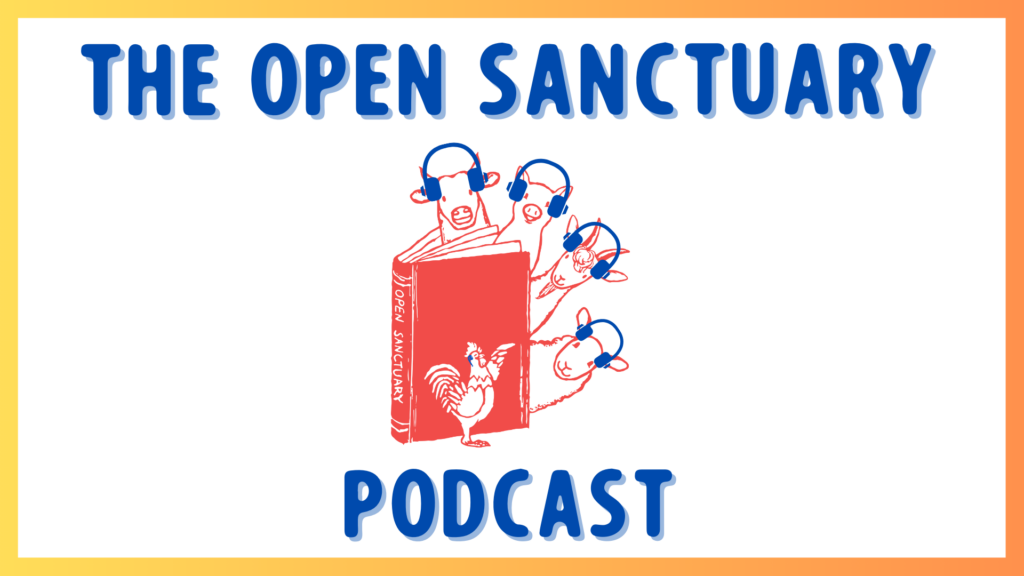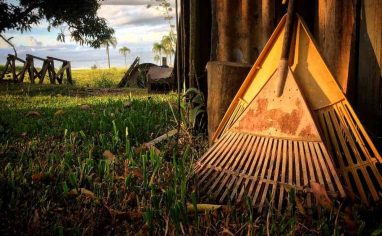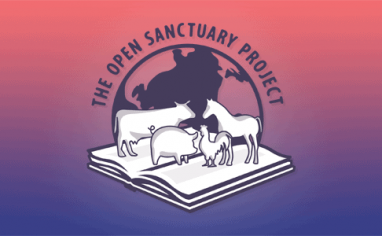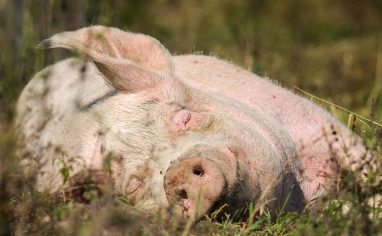
Subscribe To The Open Sanctuary Podcast
If you’d like to get the latest episodes of The Open Sanctuary Podcast, you can subscribe for free on all Podcast platforms, including Apple Podcasts and Spotify!
Episode Notes
Research Specialist Amber, Community Education Specialist Andie, and NonprofitA non-governmental organization whose primary purpose is something other than selling goods or services. Specialist Julia discuss how your animal organization can “bee” more friendly to bees and other pollinators! They offer insight into how bees and pollinators can support your sanctuary (and can help support you and your efforts), actionable tips on how to support pollinators, and ways to educate the public on how to support them as well. We also talk about how to safely promote bee and other pollinator presences for sanctuary residents and caregivers.
—
This Episode’s Referenced Open Sanctuary Project Resources:
- How To Be More Bee-Friendly At Your Sanctuary
- How To Be A Bee-Friendly Sanctuary Infographic
- Compassionate Wildlife Practices At Your Animal Sanctuary
- Compassionate Wildlife Practices At Your Sanctuary Infographic
- Going Green: Your Animal Sanctuary And The Environment
- Late Elementary-Age Sanctuary Education Lesson Plan #3
- Virtual Sanctuary Educational Programming: What Are Your Options?
- The Bee Conservancy Website
- Bee Blitz | The University of Illinois
- Picture This App
Episode Transcript (Auto-GeneratedThe following content was transcribed through an automated process and may contain transcription errors or misspellings.)
Amber Barnes: This is very exciting. We are going to be talking about bees and being more bee friendly at your sanctuary. I am Amber Barnes, the research specialist, and I am with Julia Magnus, our nonprofit specialist, as well as Andie Springirth, our community education specialist. And we know that a lot of the sanctuaries listening, you might be caring for chickens or rabbitsUnless explicitly mentioned, we are referring to domesticated rabbit breeds, not wild rabbits, who may have unique needs not covered by this resource. or horses, but also bees. So, you’ve probably heard about the concerns about bee species becoming extinct. And of course, they’re very vital to our ecosystems and to our overall survival. But of course, they are also worth saving simply because they deserve a life free from harmThe infliction of mental, emotional, and/or physical pain, suffering, or loss. Harm can occur intentionally or unintentionally and directly or indirectly. Someone can intentionally cause direct harm (e.g., punitively cutting a sheep's skin while shearing them) or unintentionally cause direct harm (e.g., your hand slips while shearing a sheep, causing an accidental wound on their skin). Likewise, someone can intentionally cause indirect harm (e.g., selling socks made from a sanctuary resident's wool and encouraging folks who purchase them to buy more products made from the wool of farmed sheep) or unintentionally cause indirect harm (e.g., selling socks made from a sanctuary resident's wool, which inadvertently perpetuates the idea that it is ok to commodify sheep for their wool).. And each one of these adorable, individual, fuzzy-bummed or not, bees is really important. And so, we’re just going to look at some steps—well, steps might be the wrong word—but just some tips, some different things that you at your sanctuary can do to be more bee friendly by providing the right space and resources for native bees in your area. So many in sanctuaries might think about wildlife in terms of predators, which is very true. You should check out our compassionate wildlife practices resource if you would like to hear a little bit more about that. But bees are also wildlife, right? And we want to understand how we can best coexist with everyone. And for bees in particular, they are so important, pollinating one in three bites of food we eat, right? So, like 80% of the world’s flowering plants. And it’s, I mean, it really is just, they’re amazing, right? Basically though, we really need to be providing care, providing ways for bees to exist since we have been doing a lot of negative things as a species with habitat loss, pesticide use, climate change, all of these things. And according to the Center for Biological Diversity, more than half of North America’s 4,000 native bee species are in decline with one in four species at risk of extinction. So, that kind of gives you an idea of how important this is on a global level, but of course on an individual level as well. And most people, I think, hear about bees and saving the bees, and they think honey bees, right? Like, “Oh, we can’t have that”. Well, honey bees are actually domesticatedAdapted over time (as by selective breeding) from a wild or natural state to life in close association with and to the benefit of humans. So, they are farmed across the world. They’re used by humans for monetary gain. People, you know, sell honey, and that means that they have a stake in their continued existence. So, like they’re not really the ones contributing the most to pollination, even though I feel like that’s kind of what we’ve been taught, even if not directly. That’s the vibe that’s out there is that honey bees are doing all this work, and they are, you know, they are doing some, but native bee species and of course other pollinators take care of the majority of pollination. A lot of species evolved to be built just right to efficiently pollinate certain types of fruits or flowers. So, I mean, honey bees, there’s just certain types that they’re not up to the task of pollinating. And obviously, once again, like they’re important as well, and we’re not, we’re not saying that. We’re just trying to highlight how important native bee species are and that honey bees are being protected by those that have a stake, unfortunately, in kind of exploiting some of their abilities. And I would like to mention briefly the solitary bees, you know, the species of bumblebees, the mason bees, and all those others that are in danger, and how their populations are greatly affected by lack of habitats, lack of food, lack of resources. So, when you see little signs or campaigns that are like, “Save the bees,” think of the native bees in your area. And Julia Magnus has some more experience with this. I would love to hear some tips and tricks for being friendly to bees.
Julia Magnus: Well, I’m happy to help, Amber Barnes. Let’s note for our audience that we do have resources that you wrote which are excellent. “How to be more Bee Friendly at Your Sanctuary” which is a written resource as well as an accompanying infographic. “How to be a Bee Friendly Infographic” which can offer you some of these tips and tricks in a pretty easily digestible form. And you did list in those spaces some of these tricks, but I also want to back up again, like you did, and mention that we also have compassionate wildlife practices resources at The Open Sanctuary Project. We’ll list those in the show notes. We also have kind of a meta resource on “Going Green: Your Animal Sanctuary in the Environment” that kind of lists all of our resources when it comes to how you can coexist with just the general world around you wherever you find yourself. And we have some other things that I think some other special treats that we will mention later in our podcast. But in your resource, “Tips and Tricks for Being Friendly to Bees,” you listed a number of steps. And I want to say that I love that. And I also think that this is a great context. I’m really happy we have this podcast so we can present this information in a way that may be more sort of holistic, integrative. Like I think by nature of written resources, as you read through, you might think of things as step by step, like do this first, then the next thing, then the next thing, whereas I think all of the steps and measures that you list in your resource are kind of more of an interplay of different things. So, the first one that you listed in your resource was “do nothing”. So, when it comes to that, my immediate thought is I think about in urban settings, “food, not lawns”. I think about the little signs that we see everywhere that say, “Pardon the weeds. I’m feeding the bees”. So, these things literally involve little to no effort. Just don’t put pesticides to grow a green lawn. A green lawn is not beneficial to bees. When it comes to the end of summer and you’re embarking into fall, when the leaves fall and you might have some of that detritus, you might have leaf litter or something in your yard, you don’t need to pick that up. You can leave that. And that actually is beneficial to bees because they find shelter. Some of them overwinter in that kind of leaf litter in that kind of space. And it just makes it so much easier for them to survive in the spring. They emerge when the temperatures get warm enough. And then once temperatures are consistently at a place where bees can thrive, then you can pick that stuff up if you want and clean up your yard. So, that’s “do nothing”. But you also have some other tips. Do you want to start on some of those too, Amber Barnes?
Amber Barnes: Sure, yeah. And one thing I would like to jump in with this is I have some tips with providing nesting spots and materials, but that also kind of just goes straight in with what you were talking about. Sometimes that is just leaving things as they are in the environment for a while. For example, where I am, we have a number of these plants that, they’re different species, but basically they’re hollow, right? And so, when they die, they kind of turn into these hollow sticks, you know, that just stick straight up. And we leave those because we have some native bee species that are solitary that burrow in there over the winter. And so, they have like this little hidey-hole in there. And so, we don’t knock them down until the spring, you know, a little ways into that, because they don’t use that forever. So, it’s also good just to kind of know, find out about the bees in your area and how different bees, like what is a nest for them, you know, like saying “provide nesting spots,” you know, like, “Well, what does that mean?” Because nesting spots and materials are different for different species. And there’s a little bit of that in the resource, but definitely do research in your area. But one thing that is really great, the one thing about this is like it’s okay. You don’t have to do all of these things, and it doesn’t have to be 100%. It’s pretty impossible to have 100% native flowers and trees. We have so many invasives, and some of those invasives are really difficult to get rid of. So, as a sanctuary, you’re already super busy, so we know that. So, it’s just like, don’t feel like you have to, like it’s all or nothing. Where I am, I’m also on the map, kind of the migration of monarchs, another pollinator. And so, in my case, trying to plant a milkweed that’s native to this area, because that is their big food source. Now, we’re focusing on bees, but that’s just kind of an example too of like understanding, you know, whose habitat is this that we are in, maybe I should say, you know, and how we can best provide food for them. So, that is one thing. So, just, you know, even you already have those things, is what’s great about it. And now there are places generally that can, you know, propagate native flowers and trees and help. Like there are people who kind of restore habitats, and I’m going to be working on that in the next year. But even simply, you’re busy, you don’t have that kind of maybe time or something, just look at what kind of flowers you have that are native that are already growing around your sanctuary. There’s clover. Now, that’s a little, there are some considerations, health considerations, for different mammals you might be taking care of, you know, like ruminants and horses, equines and camelids. So, if it’s in their pasture, so that’s kind of a different topic. But, you know, just around the sanctuary, that’s just a really easy way, just like, leave the clover, leave the dandelions. Like, I know, I know, like sometimes it’s just people are like, “Oh, no. It’s just all over. It looks messy”. That’s okay. And Julia Magnus mentioned, have that, you know, have a little sign. And even having a little sign like that educates right there. It’s something that people, you know, we don’t really think of if we are raised in an environment where all we see is the importance of like green, pristine lawns. And then if you see this, it kind of connects those dots for other people without even really having to go into it a lot. So, that’s even easy education there. Another thing are bee baths. Bee baths are super simple. You can just, you can put out, you know, like a dish with little stones in them so they have a place to land. There’s, you know, have some water so they can go up there and they can drink and they, you know. I mean, there’s so many things. There’s even like these little fake flower bee baths that you can get and put throughout your garden. So, they look kind of like a flower. So, they are painted with kind of a color that bees are often really drawn to that we can’t really see. And so, they can go there in the midst of all the other flowers and get a drink. So, that’s something else. It’s really simple, but with education, speaking of that, like having a sign and showing like, “Hey, look, all this clover and for me, like all this henbit,” you know, those little, they’ve got tiny little purple flowers and things like that. Yeah, we’re feeding, we’re feeding the bees, and there is opportunity for actually a lot of sanctuary education like little projects or lesson plans. And I would love to hear from Andie Springirth, our expert in the area here, what that could look like.
Andie Springirth: Yeah, actually, before I mention something specific on our website that I want to throw out to our listeners as a possibility to incorporate into their education programming, as you both were talking about identifying the different plants on your sanctuary’s property and in your sanctuary space, I just wanted to add that there are a lot of different apps on your phone that you can download to help you identify plants. I’m not a plant expert, though I know a lot of them. But having this app, I have one in particular on my phone called “Picture This”. And every time I take a photo of it, and it identifies a certain plant, I can add it, quote unquote, to my garden. It’s in a little folder, and I can also learn more about it. Is it native? Is it invasive? You know, it also gives information about who it can be toxic to and whatnot. So, I just wanted to add that in there as another little helpful tool for folks who may be getting new to this particular endeavor.
Julia Magnus: Yeah, that’s, I feel like we should consider adding those to show notes, maybe some of those options. I also want to emphasize what Amber Barnes was saying with respect to you don’t have to do any of these steps 100% and just offer a little bit of context from where I’m coming from with that. I do live in the city in a micro sanctuary context where we do urban agriculture, and so we do grow food, and we also grow native plants as much as possible. But when we purchased this place, we also it came with plants like lilacs. It came with plants that were non-native. And it’s okay for us not to fully uproot the lilacs. They give us joy. We love the smell of them. And so, you don’t need to be a purist about any of this, but the more you kind of integrate native plants, that’s great. If you’re growing food, you can even integrate the native plants into your food garden. So, we always have milkweed growing in our food garden. In this way, you can attract pollinators to make your food garden thrive more. So, it can be a very symbiotic and mutually helpful relationship with your pollinators. If you do these simple things, they come, they help you grow more food, that can help feed your sanctuary members and you. And it doesn’t have to be an all or nothing. You can do a mix of these things. And I do like, Amber Barnes, also that you emphasized that when it comes to bee baths, it’s good to provide them with shallow water where they can’t potentially get into trouble. And then the education component, like the little signs, and we have little food gardens out front that we also intersperse with native plants inside of them. So, people ask, and we try to put signage about what’s edible that you can take, what are native plants that are there to attract the pollinator, and why are they important aside from being pretty, because most of them are. So, yeah, the education seems like a really important component, especially since sometimes you may get neighbors who are like, “Why, why is this happening? Why are you leaving the dandelions alone?” you know? It goes a long way.
Amber Barnes: Yeah, yeah. Not just neighbors, but like internally, right? I think we all internalize this specific type of lawn look, and that’s hard from an aesthetic point of view to kind of get out of that mindset sometimes. But yeah, before I mention the lesson plan that is very pollinator and bee friendly and relevant to this podcast, I just also wanted to mention and shout out to two other educational opportunities that Amber Barnes mentioned in her resource because I think they’re wonderful, and they’re incredibly actionable and practical and doable. The first one was to utilize your social media platforms as spaces to educate your audience. So, that can just be a simple post or regular posts about pollinators in general, like bees, of course, in the context of this podcast. Stay on bees, Andie Springirth. I’m thinking of pollinators generally, but of course bees. And also, you know, I think it’s really nice to share with your audience and your constituency what your specific sanctuary and your staff and team and volunteers are doing. And that’s also helpful for folks who might be local to your community because it can be like, “Oh, we can do that.” “We can incorporate that.” “We’re right here”. And then the other one that Amber Barnes mentioned was an event called “Bee Blitz,” which I had never heard about until I read Amber Barnes’s resource. I think what I was reading that it’s hosted by the University of Illinois, I believe so. And it’s basically an opportunity for folks to do some kind of citizen science and snap photos of the bees that are buzzing around your local area and uploading those. And that gives scientists an opportunity to see what’s going on with those particular species and kind of monitor their status and what’s what’s going on in their lives. I think those are two really important educational opportunities. And the third one that I wanted to mention here today was that we have a lesson plan that’s geared specifically towards late elementary age kids, but it’s incredibly modifiable and adaptable to different age groups. I really want to emphasize that all of the lesson plans are created with that in mind, you know, depending on the needs of your particular space and staff and even potentially budget and also audience. But it’s called the “Late Elementary Age Sanctuary Education Plan Number Three”. And it’s, I know it’s a mouthful there. I should just, I should give them probably some more simple titles, but this lesson basically incorporates pollinator gardening as a tool for sanctuary educators to teach program participants about the pollinators that are native to their sanctuary’s local area and why they’re so important. So, of course, as Amber Barnes and Julia Magnus mentioned earlier, right, we know that pollinators are important to our own human species’ survival, but of course, they’re also incredibly important to keeping the Earth’s ecosystems and other non-human inhabitants in balance and strong and healthy. And this lesson plan really kind of focuses on that component as well. It also talks about other important pollinators that may be in your area like bats and butterflies and beetles and hummingbirds, which some of those might be surprising to you. I know a lot of people don’t often think about some of those species as pollinators, but they are, and they’re very important. And throughout this, you know, this lesson plan also talks about some of the threats that these different types of pollinators are facing, including what Amber Barnes mentioned earlier regarding pesticide use, fungicides, insecticides, habitat loss. A lot of these due, unfortunately, to modern agricultural and farming practices, which is kind of the tie-in for this lesson plan in terms of creating these more bee friendly and pollinator friendly sanctuary spaces, and how it ties into your actual sanctuary work. And so then the second part of the plan is to help the participants, to guide the participants in creating a pollinator garden at your sanctuary if you don’t already have one. So, there are a lot of ways to do this. We were talking before this episode, the three of us, just about the different types of areas we can create, and we mentioned it in here too earlier as well, but a lot of times it’s just doing nothing or leaving a little space set aside in your setting. But you can actually also do something really intentional, and something that’s very accessible friendly for everyone is to build or you can also purchase raised garden beds. And that makes it easier for a range of different folks, of course, because they’re lifted. So, that can be part of the project that you do together, or you can do it beforehand. And then the really fun part is kind of getting in the dirt with your participants and teaching them how to make seed balls. And of course, the seeds will depend on your area and what kinds of plants you want to grow in your space that are going to attract our bee friends. And then they get to dig and plant them in there and watch them grow. Just to kind of round this out, the final component here is to encourage the participants to kind of take this project beyond what they did during that couple hours at your sanctuary and to create small little posters to advertise your sanctuary’s pollinator garden so that they’re encouraged to kind of go outside of the sanctuary space and teach others about its importance and what they learned and why they’re doing it. So, please go check it out. As I mentioned, the plan is adaptable and modifiable, but it is, you know, a more step-by-step thing for sanctuary educators who are interested in doing something very community-based.
Julia Magnus: I love that resource so much because in addition to being full of information, it’s also just full of wonderful illustrations.
Andie Springirth: Oh, thank you.
Julia Magnus: Your artistic talents never fail to make me smile, Andie Springirth.
Andie Springirth: Thank you. So good. I appreciate that.
Julia Magnus: I also want to say in addition to being educational, and as I mentioned, it can be functional if you’re also growing food to have pollinator plants around. There’s another way that pollinator gardens can be functional. And one has to do with drainage, which is a major issue. Rain gardens are incredibly helpful when it comes to managing areas that may be flooding. There are native plants to your area that you can plant that are deep rooted, which can help mitigate some of the flooding that can happen in certain areas if you have heavy rains, which we all know our weather is getting a little bit more unpredictable these days. So, planting these natives in these areas are not only attractants for pollinators, but can help mitigate flooding issues that could be creating issues for residents, whether it’s attracting people like mosquitoes or whether it’s slipping risks or you just don’t want people getting in mud. Planting natives is helpful in that respect as well. It’s kind of a win-win.
Amber Barnes: Yeah. No, that, I mean, that’s such a great point, and you know, something that popped into my head while Andie Springirth was talking, and I was like, I need to add this actually to the resource, that in my community there are several places that host native plant sales or plant swaps, and that would be a great fun thing to invite the community out to do at your sanctuary. It doesn’t have to cost a lot or anything really, depending on how you do this. So, I mean, there you go. That’s another thing. And I was like, “Oh, yeah, going to put that in there.” “That would be great because I’m really excited to go”. And a lot of times the funds, like if you go to one in your community there, you know, a lot of times it’s actually going towards something like restoring habitat. Or, you know, we have one that’s going to support a local little veganAn individual that seeks to eliminate the exploitation of and cruelty to nonhuman animals as much as possible, including the abstention from elements of animal exploitation in non-food instances when possible and practicable as well. The term vegan can also be used as an adjective to describe a product, organization, or way of living that seeks to eliminate the exploitation of and cruelty to nonhuman animals as much as possible (e.g., vegan cheese, vegan restaurant, etc.). community kitchen that we have, where they grow food as well, and you know, then they host the little plant sale, and you know, it’s really great, and it’s an opportunity you could contact some of those types of places in your community and just be like, “Hey, you know, would you want, are you interested in having this, we could host it here?” So, that was something that popped into my head.
Julia Magnus: I super love that because it’s also an opportunity to connect with the community outside of sanctuary folks. You’re talking to folks who are in conservation. You’re talking to folks, if you’re in the city, who are either urban ag or restoration oriented, and a lot of us have very similar goals in a lot of ways. So, it’s a great way to do community outreachAn activity or campaign to share information with the public or a specific group. Typically used in reference to an organization’s efforts to share their mission. as well. I have a small clarification question. When you say swap, do you mean you swap plants with one another?
Amber Barnes: Yes, we have one at our little local library down the road. You can just come in with your like, “Oh, well, I have a ton of lemon verbena that is so easy”. And that’s the other thing is like, I have just, I just put it in little pots and things like that, and you know, then you can go down and they’ll be like, “Oh, well, you know, I have milkweed”. I’m like, “Well, I’ll give you three verbena for your one milkweed”. No, you know, like it’s just really fun. It’s pretty fun actually. Like we, we have that going on with edibles and with natives. And even in our neighborhood, people will put out tables and be like, “We have seedlings.” “Do you have seedlings?” “What do you have?” “Let’s exchange them”. And yes, it’s a great chance to connect with your neighbors. It’s a great chance to get more plants, which everybody always wants, because plants rock. And, yeah, it’s so much fun.
Julia Magnus: Yeah, absolutely. I, I clearly we’re all plant nerds and like little pollinator nerds here. So, it’s such an exciting way to connect with communities, like you said, that maybe you wouldn’t connect with otherwise. Like maybe they wouldn’t know about the sanctuary, but also maybe you don’t meet on that quite that same level of philosophy. But getting an opportunity there for your community to know you, to build trust, to build bonds there, even if you’re doing different things, what a beautiful thing. Like, really. Yeah, yeah. Bolsters community, you know. Yeah. All the good stuff. Anyway, that’s great.
Amber Barnes: One thing that I was thinking of too that I wanted to hit on is like, okay, so everyone might be listening and be like, “Well, this sounds great, but what about the fact that we had carpenter bees, and they were just like burrowing little wood holes in our the goat living area or something?” There are things that you can do. You can seal those areas. You can keep residents safe. You’re concerned about the integrity of their living spaceThe indoor or outdoor area where an animal resident lives, eats, and rests., or of them maybe, little conflict there if somebody’s getting into their space and the bees feel like they need to protect themselves or something. There’s a lot that you can do. You could, like I said, you can seal cracks in different areas. As far as leaving things for bees and other pollinators to use over the winter and different, or even in the spring, it just looks a little different. You still can make sure things are cleaned up around the living space, around the buildings at your property. That’s pretty important, not only for the bee situation where you’re like, “Hey, let’s keep a little space maybe, you know, so their homes can kind of be on their own,” but also that goes back to our compassionate wildlife practices. We want to coexist with our wildlife friends and like little mice. You got your little field mice. Well, they love, they love some nice coverage right near the grain bins, you know. And so just keeping those areas cleaned up though will help instead of telling someone what not to do, you show them what they can do. Like, you know, so show the bees, show the mice, like, “Look at all this stuff over here that kind of draws away from resident spaces”. So, coexisting, everyone.
Andie Springirth: Yeah. And also just to add, protecting your residents also includes your human residents. Because there might be some folks listening who are like, “I’m deathly allergic to bees”. So, being mindful, like Amber Barnes just mentioned, like if you have a staff member or a volunteer who has a bee allergy, like being mindful where you do place those attractive zones and little spaces for our bee friends to be, you know, outside of the purview and the spatial realm of those folks.
Amber Barnes: All right. Well, while I think we could all talk about bees and pollinators and flowers and whatnot all day, of course, I think that probably wraps up this podcast. And, you know, thank you both for joining and having this really fun conversation that really gives everyone some things that we can all do that, honestly, can help and don’t have to take a lot of time. And it’s just, it’s nice for us to be able to do something actionable to help. And thanks for having this conversation with us. We will have all the resources we mentioned in the show notes. So, be sure to check those out. And of course, the full resource has more information specifically. But yeah, thanks for joining us. And I have to say this, be well.
Julia Magnus: Why?
Amber Barnes: I had to do it.
Julia Magnus: You had to do it.
Amber Barnes: I’m sorry. I’m sorry. Not sorry.
Andie Springirth: Yep.
Amber Barnes: I’m going to buzz off now.
Julia Magnus: Oh, that really stings, Amber Barnes. Yeah.
Amber Barnes: Oh, thank you.
Julia Magnus: Oh, no. Now that everyone hates us.
Amber Barnes: Oh, we hope that we’re a fraction, you know, amusing to other people as we are to ourselves. All right, everybody. Till next time.

Got A Podcast Idea? Contact Us!
If you have a topic or question you’d love to hear our staff address on The Open Sanctuary Podcast, please get in touch via our contact form!








